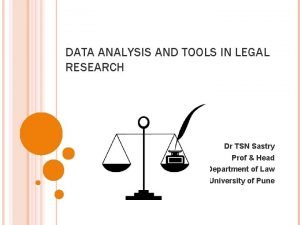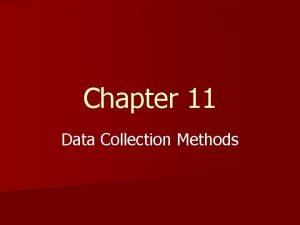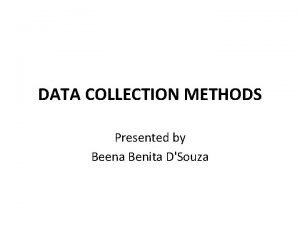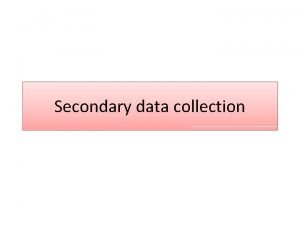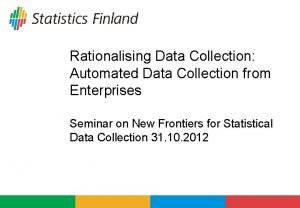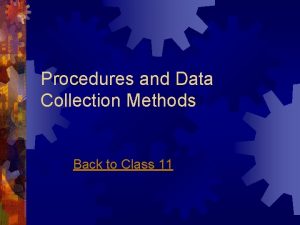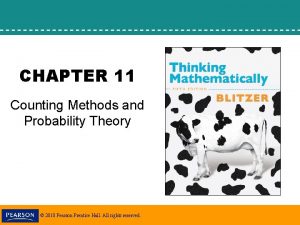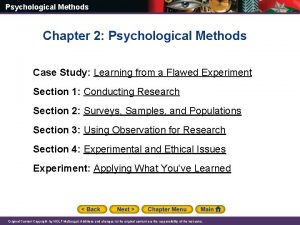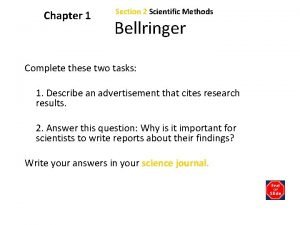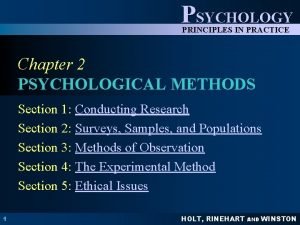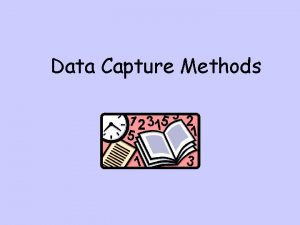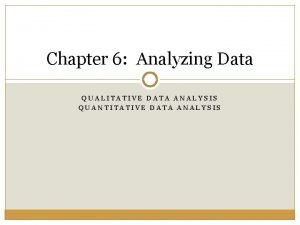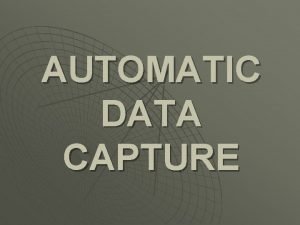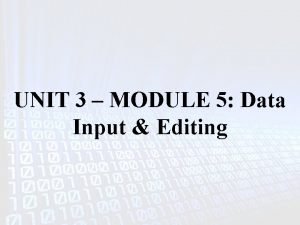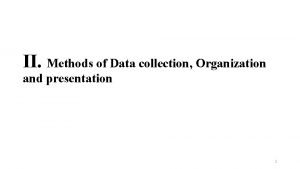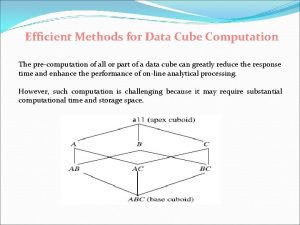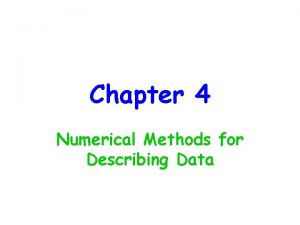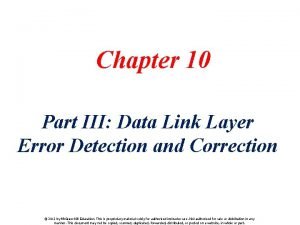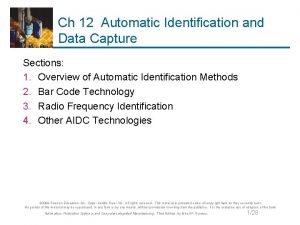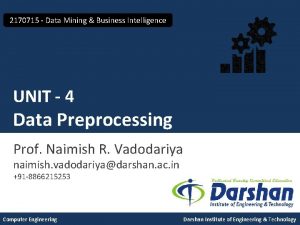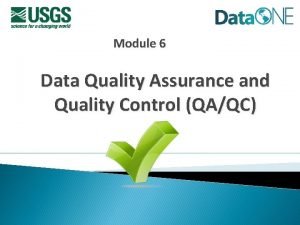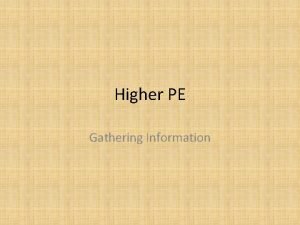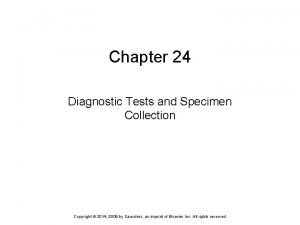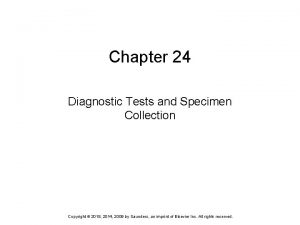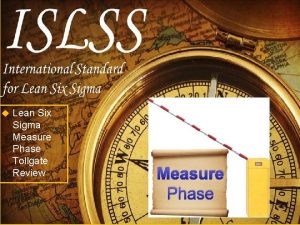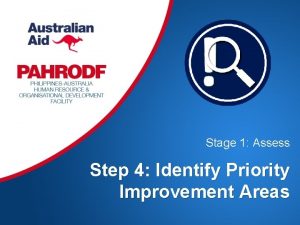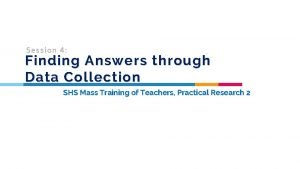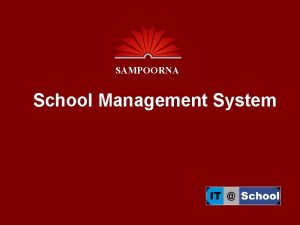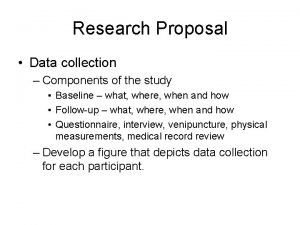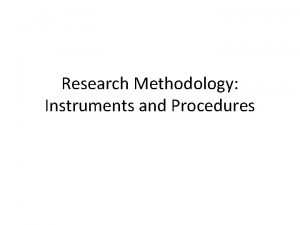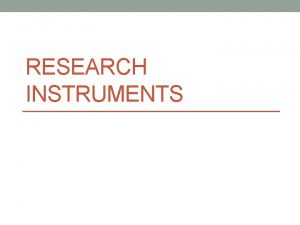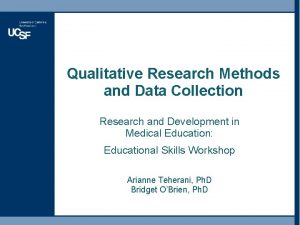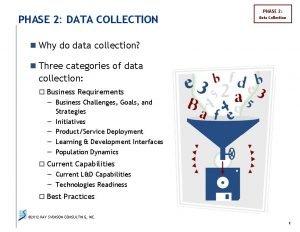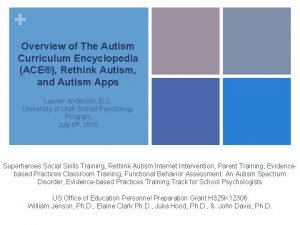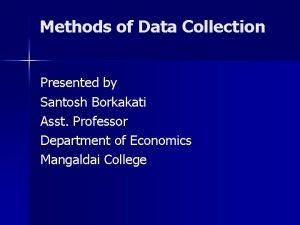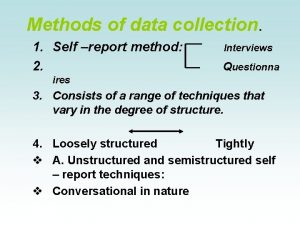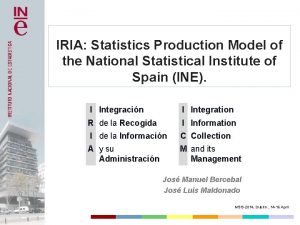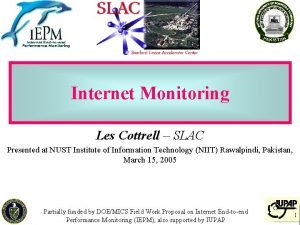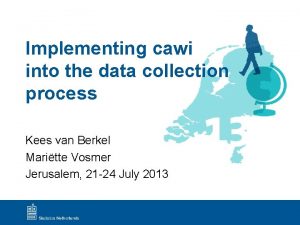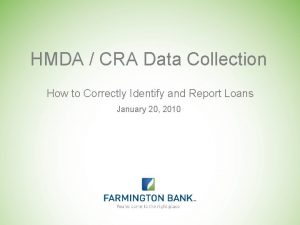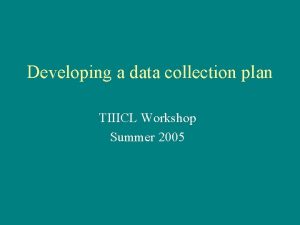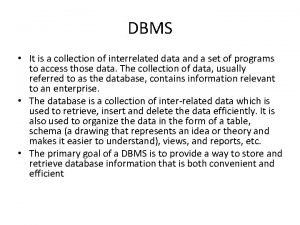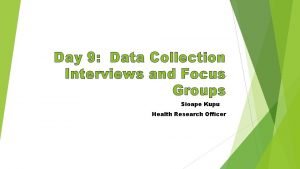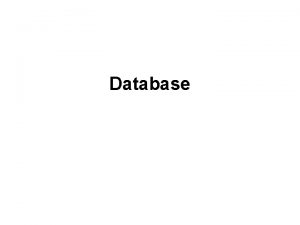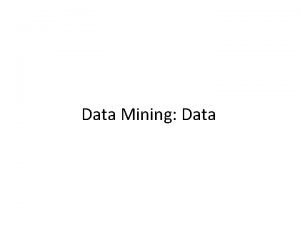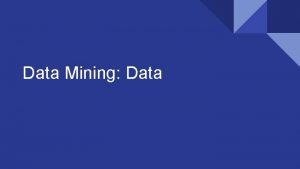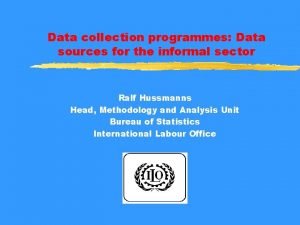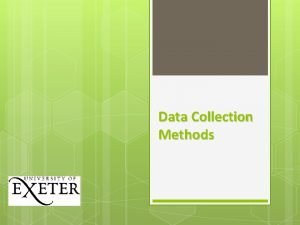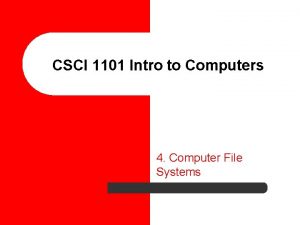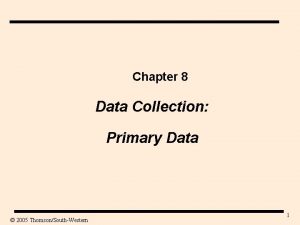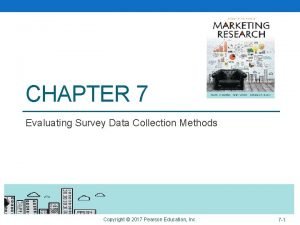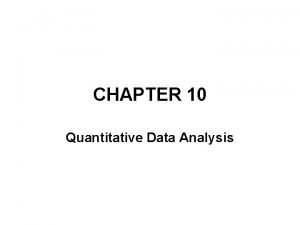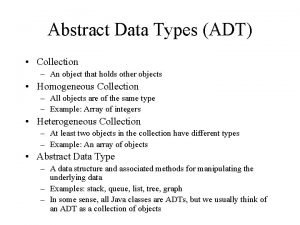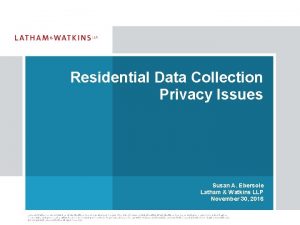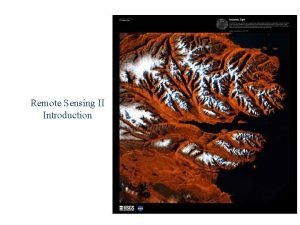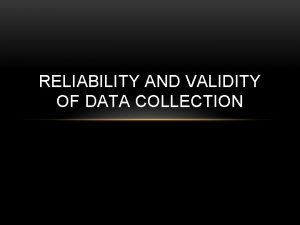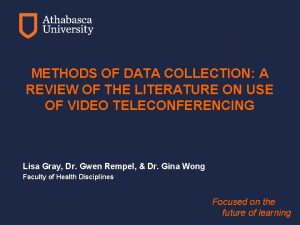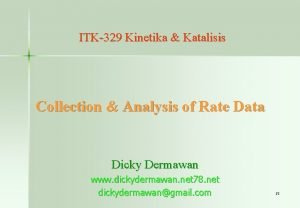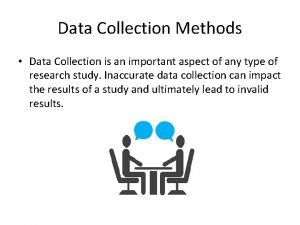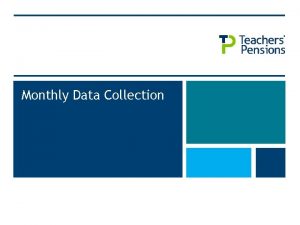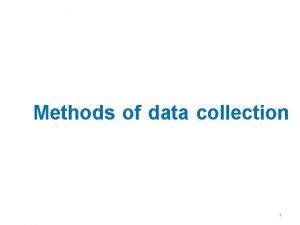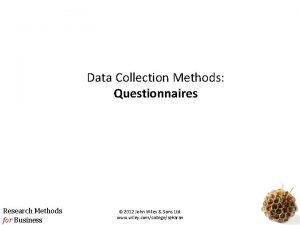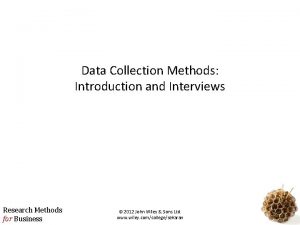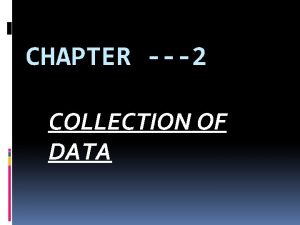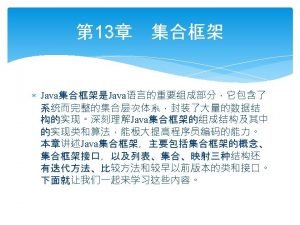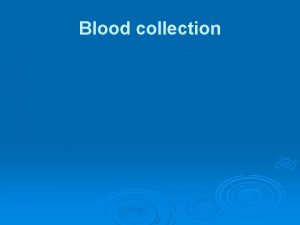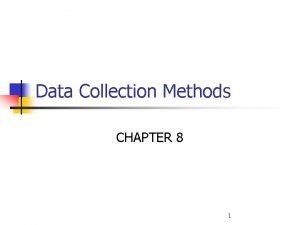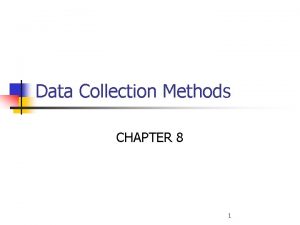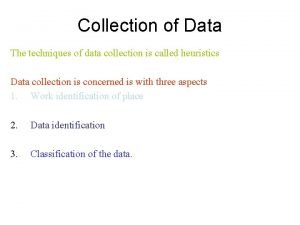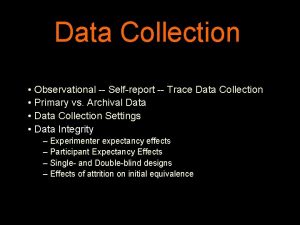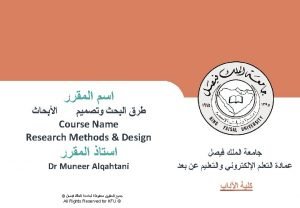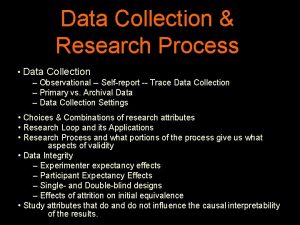Chapter 10 l Data Collection Methods Data Collection








































































- Slides: 72

Chapter: # 10 l Data Collection Methods

Data Collection Methods, Settings, and Sources of Data collection methods: ~ Interviews. ~ Questionnaires. ~ Observation. ~ Motivational techniques. l Setting. l Sources. l 2

Setting In the natural environment of the workplace. l In experimental lab settings. l 3

Sources Primary. l Secondary. l 4

Interviewing Unstructured and structured interviews. l Tips for interviewing. l Face-to-face and telephone interviews. l Computer-Assisted interviews. l 5

Unstructured and Structured Interviews l Unstructured Interviews. – Interviews conducted with the primary purpose of identifying some important issues relevant to the problem situation, without prior preparation of a planned or predetermined sequence of questions. 6

Unstructured and Structured Interviews (cont. ) Structured interviews: – Interviews conducted by the researcher with a predetermined list of questions to be asked of the interviewee. l Training interviews. l 7

Some Tips to Follow in Interviewing Interviewer. l Interviewees. l Situational: – Nonparticipants. – Trust level and rapport established – the physical setting of the interview l 8

The Questioning Technique l l l Funneling. Unbiased questions. Clarifying issues. Helping the respondent to think through issues. Taking notes. 9

Face-to-Face and Telephone Interviews Face-to-Face Interviews: ~ Advantages. ~ Disadvantages. l Telephone Interviews: ~ Advantages. ~ Disadvantages. l 10

Face-to-Face Interviews Advantages: Researcher can adapt the questions as necessary, clarify, doubts, and ensure that the responses are properly understood, by repeating or rephrasing the questions. l Disadvantages: the geographical limitations they may impose on the surveys and the vast resources needed if such surveys need to be done nationally or internationally l 11

Telephone Interviews Advantages: From the researcher’s point of view, is that a number of different people can be reached in a relatively short period of time. l Disadvantages: Respondent could unilaterally terminate the interview without warning or explanation, by hanging up the phone. l 12

Additional Sources of Bias in Interview Data Strike. l Layoffs. l and the like. l 13

Computer-Assisted Interviewing CATI (Computer-Assisted Telephone Interviewing) and CAPI (Computer. Assisted Personal Interviewing). l Computer-Aided Survey Services. l 14

CATI (Computer-Assisted Telephone Interviewing) l Used in research organizations, is useful inasmuch as responses to surveys can be obtained from people all over the world. 15

CAPI (Computer-Assisted Personal Interviewing) l Has an advantage in that it can be self -administered. 16

Advantages of Computer Packages Indexing. l Retrieval. l 17

Questionnaires l A preformulated written set of questions to which respondents record their answer, usually within rather closely defined alternatives. 18

Questionnaires (cont. ) Personally administered questionnaires. l Mail questionnaires. l 19

Guidelines for Questionnaire Design The wording of the questions. l Planning of issues of how the variables will be categorized, scaled, and coded after receipt of the responses. l The general appearance of the questionnaire. l 20

Principles of Wording Content and purpose of the question. l Language and wording of the questionnaire. l Type and form of questions. l 21

Principles of Wording (cont. ) Open-Ended versus Closed questions. l Positively and negatively worded questions. l Biases in questions. l 22

Biases in Questions l Double-Barreled Questions – Refers to the improper framing of a question that should be posed as two or more separate questions, so that the respondent can give clear and unambiguous answers. l Ambiguous Questions – Questions that are not clearly worded and likely to be interpreted by respondents in different ways. 23

Biases in Questions (cont. ) l Recall-Dependent Questions – Questions that elicit from respondents information that involves recall of experiences from the past that may be hazy in their memory. l Leading Questions – Questions phrased in such a manner as to lead the respondent to give the answers that the researcher would like to obtain. 24

Biases in Questions (cont. ) l Loaded Questions – Questions that would elicit highly biased emotional responses from subjects. l Social Desirability – The respondents’ need to give socially or culturally acceptable responses to the questions posed by the researcher even if they are not true. 25

Biases in Questions (cont. ) • Length of Questions • Sequencing of Questions 26

Classification Data of or Personal Information Age. l Educational level. l Marital status. l Income. l 27

Cross-Cultural Research Special issues in instrumentation for cross-cultural research. l Issues in data collection. l 28

Special Issues in Instrumentation for Cross-Cultural Research Vocabulary equivalence. l Idiomatic equivalence. l Conceptual equivalence. l 29

Issues in Data Collection Response equivalence. l Timing of data collection. l The status of the individual collecting. l 30

Principles of Measurement l The scales and scalling techniques used in measuring concepts, as well as the assessment of reliability and validity of the measures used. 31

General Appearance or “Get Up” of The Questionnaire l A good introduction, wellorganized introductions, and neat alignment of the questions are all important. 32

Important Aspect of Questionnaires A good introduction. l Organizing questions, giving instructions and guidance, and good alignment. l Personal data. l 33

Important Aspect of Questionnaires (cont. ) Information on income and other sensitive pesonal data. l Open-ended question at the end. l Concluding the questionnaire. l 34

Eletronic Questionnaire Design and Surveys l The CAPPA system, which facilitates the preparation and administration of questionnaires, is particularly useful for marketing research. 35

Personal or Face-to-Face Interviews Advantages: l l l Can establish rapport and motivate respondents. Can clarify the questions, clear doubts, add new questions. Can read nonverbal cues. Can use visual aids to clarify points. Rich data can be obtained. CAPI can be used and responses entered in a portable computer. 36

Personal or Face-to-Face Interviews (cont. ) Disadvantages: l l l Takes personal time. Costs more when a wide geographic region is covered. Respondents may be concerned about confidentiality of information given. Interviewers need to be trained. Can introduce interviewer biases. Respondents can terminate the interview at any time. 37

Telephone Interviews Advantages: Less costy and speedier than personal interviews. l Can reach a wide geographic area. l Greater anonymity than personal interviews. l Can be done using CATI. l 38

Telephone Interviews (cont. ) Disadvantages: Nonverbal cues cannot be read. l Interviews will have to be kept short. l Obsolete telephone numbers could be contacted, and unlisted ones omitted from the sample. l 39

Personally Adminstered Questionnaire Advantages: l l l Can establish rapport and motivate respondent. Doubts can be clarified. Less expensive when adminstered to groups of respondents. Almost 100% response rate assured. Anonymity of respondent is high. 40

Personally Adminstered Questionnaire (cont. ) Disadvantages: l Organizations may be reluctant to give up company time for the survey with groups of employees assembled for the purpose. 41

Mail Questionnaires Advantages: l l l Anonymity is high. Wide geographic regions can be reached. Token gifts can be enclosed to seek compliance. Respondent can take more time to respond at convinience. Can be administered electronically, if desired. 42

Mail Questionnaires (cont. ) Disadvantages: Response rate is almost always low. a 30% rate is quite acceptable. l Cannot clarify questions. l Follow-up procedures for nonresponses are necessary. l 43

Electronic Questionnaires Advantages: l l l Easy to administer. Can reach globally. Very inexpensive. Fast delivery. Respondents can answer at their convenience like the mail qeustionnaire. 44

Electronic Questionnaires (cont. ) Disadvantages: Computer literacy is a must. l Respondents must have access to the facility. l Respondent must be willing to complete the survey. l 45

Other Methods of Data Collection Observational surveys. l Structured versus unstructured observational studies. l Advantages and disadvantages of observasional studies. l Biases in observational studies. l 46

Observational Surveys Nonparticipant-observer. l Participant-observer. l 47

Nonparticipant-Observer l The researcher can collect data in the role of a reseacher without trying to become an integral part of the organizational system. 48

Participant-Observer The researcher can also play the role of the participant-observer. l The researcher enters the organizaton o the reseach setting, actually becoming a part of the work team. l 49

Structured versus Unstructured Observervational Studies l Structured Observational Studies: Where the observer has a predetermined set of categories of activities or phenomena planned to be studies. 50

Structured versus Unstructured Observervational Studies (cont. ) l Unstructured Observational Studies: Observing events that are happening may also be a part of the plan as in many qualitative studies, the observer will record almost everything that is observed. 51

Advantages of Observational Studies The data obtained through observation of events. l It is easier to note the effects of environmental influences on specific outcomes. l It is easier to observe certain groups of individuals. l 52

Disadvantages of Observational Studies It is necessary for the observer to be physically present. l This method of collecting data is slow, tedious and expensive. l 53

Disadvantages of Observational Studies (cont. ) Observer fatigue could easily set in, which might bias the recorded data. l Observers have to be trained in what and how to observe, and ways to avoid observer bias. l 54

Data Collection Through Mechanical Observation l There are situations where machines can provide data by recording the events of interest as they occur, without a researcher being physically present. 55

Projective Methods Word-association techniques. l Sentence completion. l Thematic Apperception Tests (TAT). l Inkblot test. l 56

Secondary Data l Information gathered by someone other than reseacher conducting the current study. 57

Some Special Data Sources l Focus Groups. Used for exploratory studies, making generalizations based on the information generated by them, or for purposes of sample survey. 58

Some Special Data Sources (cont. ) l Other secondary sources of information: 1. Trace measures. 2. Unobtrusive measures. 59

Panels l Like fokus groups, are another source of information for reseach purposes. 60

Static and Dynamic Panels Static: The same members serve on the panel over extended periods of time l Dynamic: The panel member change from time to time as various phases of the study are in progress. l 61

Multimethods of Data Collection l Because almost all data collection methods have biases associated with them, colleting data through multimethods and from multiple sources lends rigor to research. 62

Face-to-Face Interviews l Advantages: Provide rich data, offer the opportunity to establish rapport with the interviewees, and help to explore and understand complex issues. l Disadvantages: Have the potential for introducing interviewer bias and can be expensive if large number of subjects are to be personally interviewed. 63

Telephone Interviews l Advantages: Help to contact subjects dispersed over various geographic region and obtain responses from them immediately on contact. l Disadvantages: The interviewer cannot onserve the nonverbal responses of the respondents, and the interviewee can not block a call. 64

Personally Administering Questionnaires l Advantages: ~ Establish rapport with the respondents while introdcing the survey. ~ Provide clarifications sought by the respondents on the short. ~ Collect the questionnaires immediately after they are completed. l Disadvantages: Administering questionnaires personally is expensive, especially if the sample is geographically dispersed. 65

Mail Questionnaires l Advantages: Are advantageous when responses to many questions have to be obtained from a sample that is geographically dispersed, or it is difficult or not possible to conduct telephone interviews to obtain the same data without much expense. l Disadvantages: Mailed questionnaires usually have a low response rate and one cannot be sure if the data obtained are biased. 66

Observational Studies l Advantages: Help to comprehend complex issues through direct observation and then, if possible, asking questionsto seek clarifications on certain issues. l Disadvantages: They are expensive, since long periods of observation are required, and observer bias may well be present in the data. 67

Managerial Advantage Know how to phrase unbiased questions to elicit the right types of useful responses. l As a manager, you will be able to differentiate between good and bad questions used in surveys. l 68

Ethics in Data Collection Ethics and the reseacher. l Ethical behaviors of respondents. l 69

Ethics and The Reseacher Treating the information given by respondent. l Reseachers should not misrepresent the nature of the study to subjects, especially in lab experiments. l Personal or seemingly intrusive information should not be solicited. l 70

Ethics and The Reseacher (cont. ) No one should be forced to respond to the survey. l Nonparticipant observers should be as nonintrusive as possible. l In lab studies, the subjects should be debriefed with full disclosure of the reason. l 71

Ethics Behaviors of Respondents The subject, once having exercised the choice to participate in a study, should cooperate fully in the task ahead. l The respondent also has an obligation to be truthful and honest in the responses. l 72
 Types of data collection methods
Types of data collection methods Discuss the importance of data in a legal research.
Discuss the importance of data in a legal research. Observational data collection method
Observational data collection method Data collection methods observation
Data collection methods observation Primary data means
Primary data means Automated data collection methods
Automated data collection methods Metal coping fpd
Metal coping fpd Collection methods and procedures
Collection methods and procedures Landsat collection 1 vs collection 2
Landsat collection 1 vs collection 2 D/a 30 days after sight
D/a 30 days after sight Define data collection method
Define data collection method The terms external secondary data and syndicated
The terms external secondary data and syndicated Chapter 19 methods of therapy
Chapter 19 methods of therapy Chapter 11 counting methods and probability theory answers
Chapter 11 counting methods and probability theory answers Single blind study
Single blind study Scientific methodswhat is a hypothesis?
Scientific methodswhat is a hypothesis? Psychology principles in practice
Psychology principles in practice Research methods for business students chapter 5
Research methods for business students chapter 5 Data capture methods
Data capture methods Data analysis methods
Data analysis methods Automatic data capture methods
Automatic data capture methods Principles of input design
Principles of input design Methods of gathering data national 5 pe
Methods of gathering data national 5 pe Data input methods
Data input methods Collection organization and presentation of data
Collection organization and presentation of data Efficient methods for data cube computation
Efficient methods for data cube computation Methods to avoid false discoveries in data mining
Methods to avoid false discoveries in data mining Chronicle of higher education
Chronicle of higher education Block coding in data link layer
Block coding in data link layer Automatic identification and data capture pdf
Automatic identification and data capture pdf Binning methods in data mining
Binning methods in data mining What is quality control definition
What is quality control definition Cycle of analysis pe
Cycle of analysis pe Chapter 24 diagnostic tests and specimen collection
Chapter 24 diagnostic tests and specimen collection Chapter 24 diagnostic tests and specimen collection
Chapter 24 diagnostic tests and specimen collection The seven s's of crime scene investigation
The seven s's of crime scene investigation Data gathering for quantitative research
Data gathering for quantitative research Tollgate review
Tollgate review Sample of priority improvement areas
Sample of priority improvement areas Finding answers through data collection module
Finding answers through data collection module Sampoorna training management system
Sampoorna training management system Data gathering procedure in research proposal
Data gathering procedure in research proposal What is definition of terms in research
What is definition of terms in research Research instruments examples
Research instruments examples Define data collection method
Define data collection method Phase 2 data
Phase 2 data Autism encyclopedia curriculum
Autism encyclopedia curriculum Pantry and store audits
Pantry and store audits Self-report method
Self-report method Www iria ine es
Www iria ine es Network data collection at slac
Network data collection at slac Cawi data collection
Cawi data collection Cra loan data collection grid
Cra loan data collection grid Data collection plan
Data collection plan A collection of interrelated data files or tables
A collection of interrelated data files or tables Focus group interview schedule
Focus group interview schedule Is a structured collection of data
Is a structured collection of data Nominal attribute in data mining
Nominal attribute in data mining Discretization and binarization in data mining
Discretization and binarization in data mining Informal data collection
Informal data collection A major advantage of primary data collection is that
A major advantage of primary data collection is that Data collection instruments in qualitative research
Data collection instruments in qualitative research A named collection of data on a storage medium
A named collection of data on a storage medium Qualitative and quantitative data analysis
Qualitative and quantitative data analysis Structured undisguised questionnaire
Structured undisguised questionnaire What is self administered survey
What is self administered survey Statistical treatment of data example
Statistical treatment of data example Collection (abstract data type)
Collection (abstract data type) Residential data collection
Residential data collection In situ data collection
In situ data collection Validity of data
Validity of data Conclusion of data collection
Conclusion of data collection Collection and analysis of rate data
Collection and analysis of rate data

